
12.12.2016
Xavier Acarín and Trajal Harrell discuss the multiple performance traditions that inform Harrell’s dance practice.
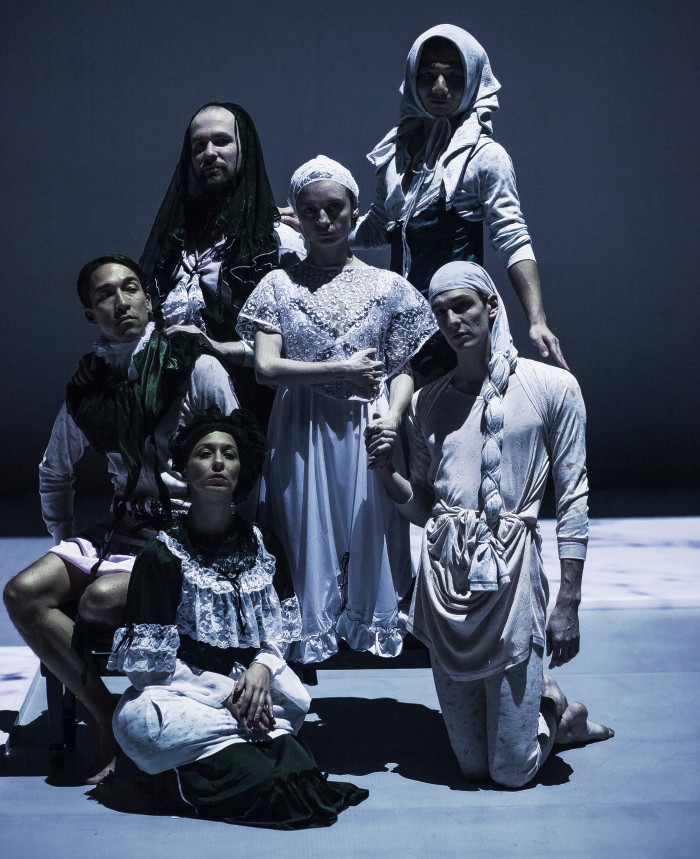
Xavier Acarín: Terremoto’s current issue “Eternal Life,” explores the connections between contemporary performance, spirituality, and ancient traditions. With this in mind, could you talk about how your choreographies relate to the ritualistic and the ceremonial? How do you consider the ways rituals link mythological origins with the present, breaking with the usual time flow, and creating new bonds or understandings of the self? To what extent do your pieces function as rituals?
Trajal Harrell: Performance is always at some level a ritual, the medium contains a sense of gathering people at an appointed time in a particular space. In my work I take a lot of inspiration from ancient Greek theater, which included many ritualistic traditions. My recent piece The Return of La Argentina is perhaps the most ritualistic, and this is a period of my work where I am looking to the modern Japanese dance theater of butoh through the theoretical lenses of the modern dance of vogue or voguing that evolved from the Harlem ballroom scene, and looking at modern dance through the theoretical lenses of butoh. Of course butoh, as a dance practice took a lot of its source material from Japanese folk traditions, rituals, and shamanistic practices. As well, recent research shows how butoh was extremely influenced by Katherine Dunham, and her work on vodun. In The Return of La Argentina, I attempt to archive another piece, that of Admiring La Argentina by Kazuo Ohno which was directed by Tatsumi Hijikata. I only perform the piece as a ritual. There are certain elements that need to be invoked in order for the piece to be actualized.
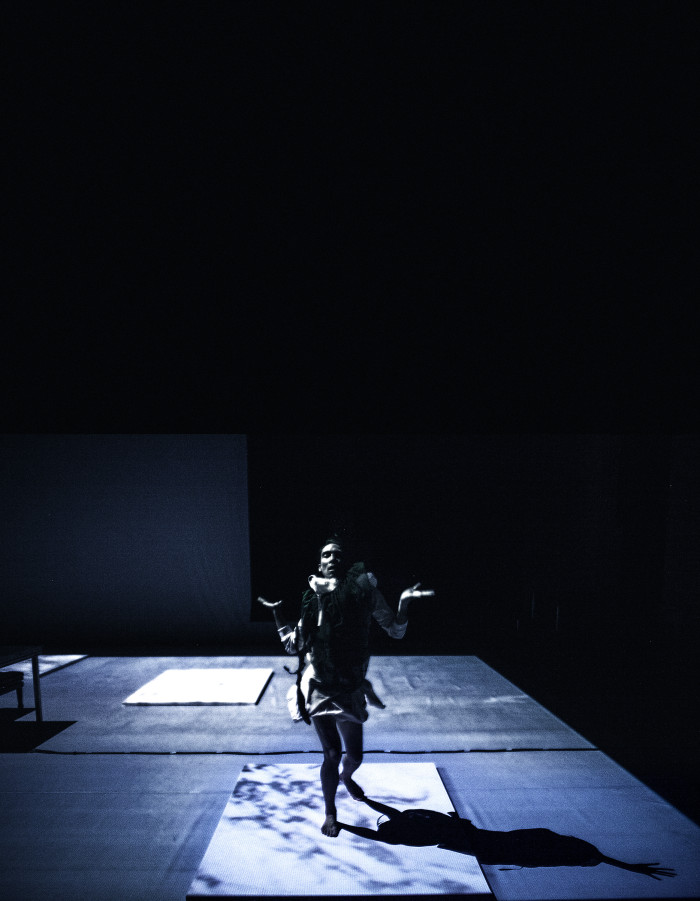
XA: You have worked with historical precedents such as the Judson Church crowd, the Harlem voguing scene, and more recently with Dominique Bagouet. In approaching these research projects and collaborations, do you feel like a medium? Someone who canalizes energy to re-perform, re-actualize it, perpetuating a spirit, expanding the past into the present. How and why do you work with history?
TH: I’m interested in the historical imagination as a tool that creates possibilities. It is one of the things art can do. It can help us to overcome the things we think are impossible. Going into the cracks and fissures of history is one of the ways in which we can begin to uncover new kinds of possibilities in the world, because we know that history is not necessarily the most truthful, the most real, nor the most accurate story. I try to empower the historical imagination and that has been a part of my practice since 2001 when I started looking at the relationship between voguing and early postmodern dance. In a way, I employ history as a tool to get into the present and engage the audience in a proposition for a historical impossibility that creates togetherness and propels spectators into the now.
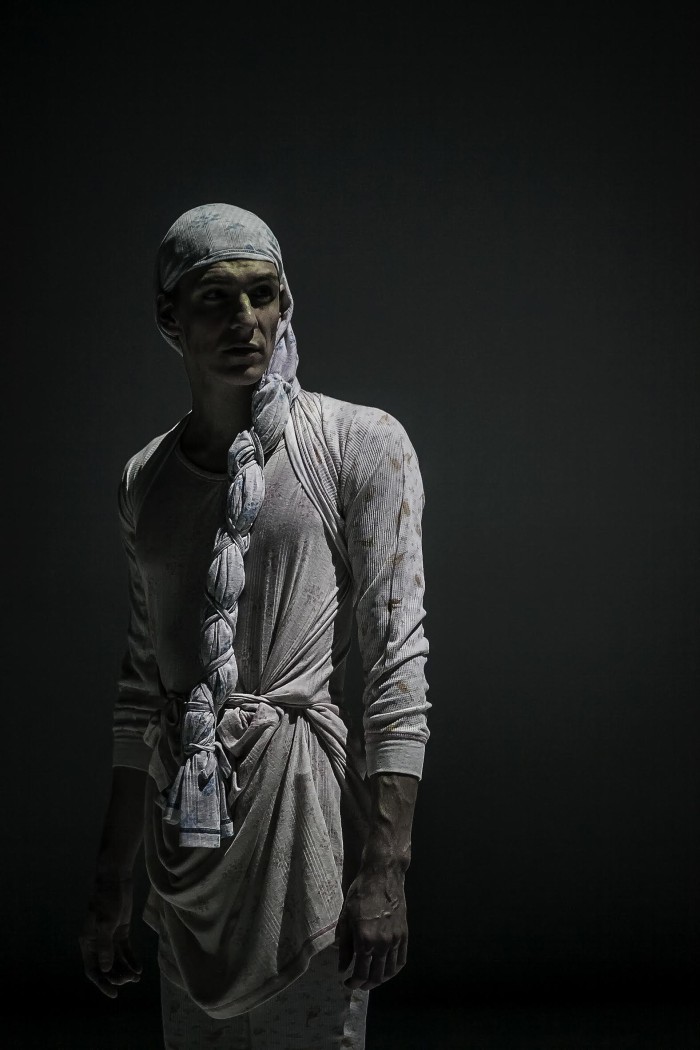
XA: A very distinctive element of your performances is the use and presence of clothing. The clothes that you and your performers wear are very specific. They function as the wardrobe for a ceremony, something that provokes performativity. As a viewer, I see a reciprocity between the piece of clothing and the performer that stimulates a co-definition, evoking otherness, and articulating difference. (M)imosa was particularly fantastic in such an endeavor. While clothing has always been essential to theater and performance, I wonder if you have other references from the visual arts that you consider?
TH: This came out from my research on the fashion spectacle and its development initially in the court of Louis XIV, the same court where ballet came from. I was looking at this from the perspective of voguing and their appropriation of fashion spectacle and language. This became an architectural strategy in the work as I was also working with pedestrianism, and thinking about the idea of realness in voguing. This theme is now hyper-developed in my work and has become relevant in many of my projects. One of my references is the designer Rei Kawakubo, whose work I think relates to Japanese culture and artistic forms and re-thinks the female form, femininity, objectification, and sexuality through clothing. In all of my shows there’s a fashion runway going on, it’s part of the architectural space of the work. And of course, fashion is connected to cultural rituals, to commercialization, and to our pedestrian display of the body. All of this together produces a very contemporized form of the ritual.
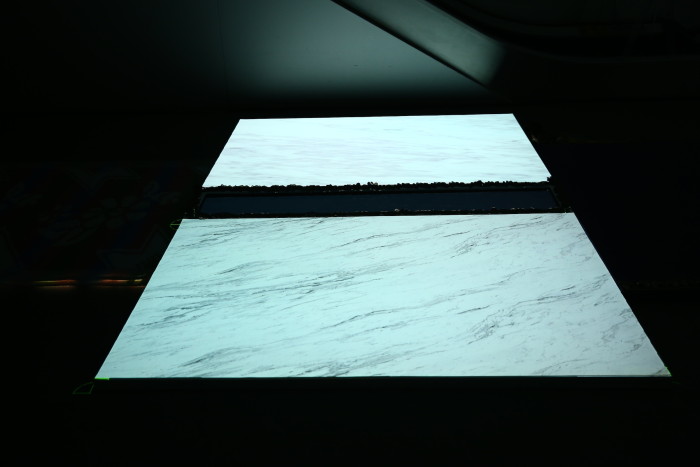
XA: We could say similar things of your sets. When I last saw you perform In the Mood for Frankie at MoMA,you used the corridor near the elevators, a transit space daily crossed by hundreds of visitors. Your performances were at night—I saw the 11:30 pm show—and at that time MoMA has a different feeling. That area of New York seems weirdly empty on a Saturday night. The performance itself was rich with historical and aesthetic references that contributed to a ghostly presence. I felt the space was designed to make us feel a specific sense of intimacy, like a séance to invoke spirits. How did you design that space? There was a carpeted floor prop that was particularly haunting; it was more than a prop that marked a score for movement, it worked as an energetic device.
TH: All of this work came out of my research on Butoh and the first piece I did at MoMA in 2013 which was Used, Abused, and Hung Out to Dry. On that occasion the audience was asked to leave their shoes in the area that we now used for In the Mood for Frankie. I thought it was an interesting way to work with performance in the museum in a space that was not designed for this purpose. It was specially opposing the huge atrium upstairs, which is a very visible and grand space for performance. So, I chose a space that is very difficult for performance. I made this piece in India, working on the theme of muses. Working in the studio in Delhi, I wanted to make a piece that came out of all the inspirations and muses that were related to this research. So, I wanted to go to the studio and see how all these references appeared, figures such as Rei Kawakubo, Wong Kar Wai, Katherine Dunham, Kazuo Ohno, Tatsumi Hijikata, and Yoko Ashikawa. I was very aware of making a mix of folk and contemporary, similar to butoh’s mix of references to the ritualistic and the ceremonial, but was also thinking about sculptural and installation practices. So the kind of materials that attracted me were coming from a variety of places in Delhi, from vintage stores, to street markets, and I knew they were going to be juxtaposed to the projections on the platforms.
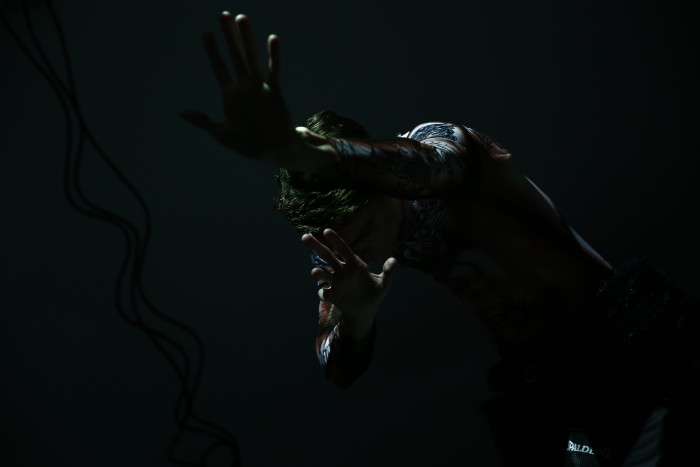
I am very interested in the original impact of butoh and how it relates to taboo and the radicalized violence that it created when it entered the world. Of course, I can only read about it and imagine. So it is a historical impossibility and I am investing myself in recreating this impact of butoh, but I can never really complete the action. All the things you mentioned exemplify my way of thinking about the aesthetic potentialities that I am invoking in the work. But they are not so strategic. I work with what I am attracted to, I am aware of the oppositions, and I am problematizing my own “orientalism.” For the project, I was particularly invested in creating an installation as a sculptural stage for dance. For the first time I wanted to make just a dance because I have been working with a lot of complex performative structures in my projects, and this time I wanted to evoke a very specific feeling from dance alone. No singing, no theater script, and no words. In Delhi you can be in a very rural space and then within a few feet, a contemporary setting, and I wanted to work with this juxtaposition. Some of the materials like the tapestries and the rugs come from there. I wanted these materials and this kind of space hovering between historical and cultural temporalities to hold this dance. Somehow I imagine this as connected to the original impact of butoh, though it’s only a feeling I have, which is not based at all on trying to imitate those original works.
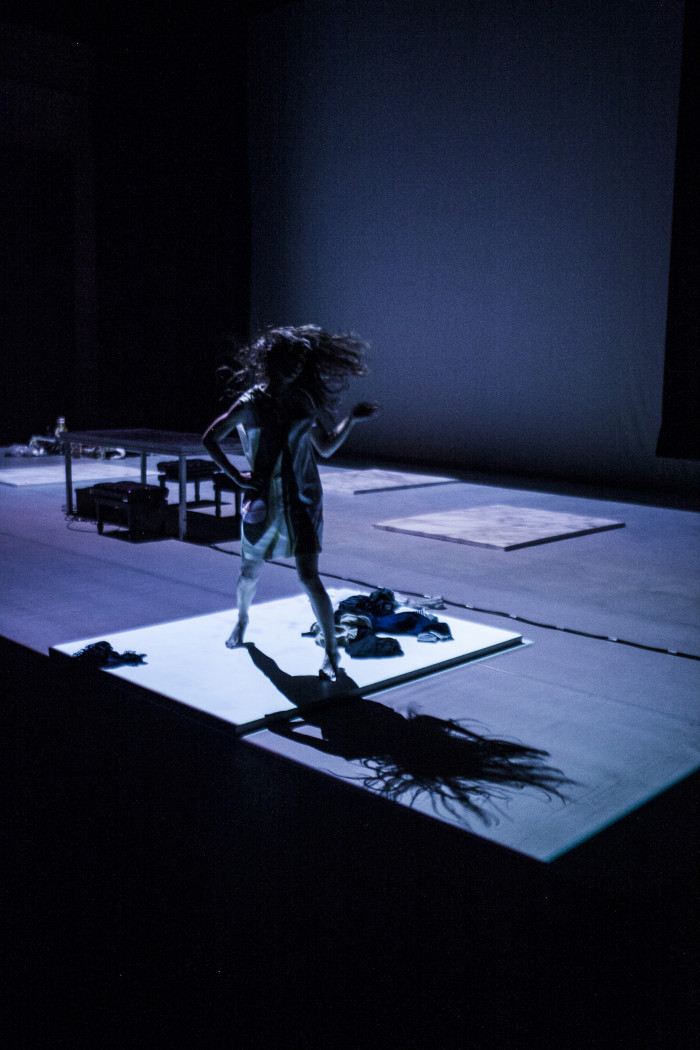
XA: Your work has contributed to challenging the canon derived from the Judson Church (or at least Yvonne Rainer’s version of the Judson Church) by introducing emotions and realness. Your work engages contemporary dance with other narratives—for instance, the way voguing provides a vivid lens through which to consider intersecting issues of gender, class and race. In turn your compositions appear to be using typical post-modern tools, such as deconstruction, alternative histories, appropriation, multiplicity of references, while you have also emphasized research as a way of working. How do you usually work and compose? Is it possible to articulate a method? Is this an intuitional process? How much of this is serendipity and how much of serendipity is magical?
TH: I always say that I don’t know how to make the dance. I was just co-teaching with Anri Sala in Vienna and one of the things we connected over was the idea of beginning again. When I go to the studio, it’s like starting over. I don’t know—there’s an impetus of doing something that I don’t necessarily know how to do or that I am confused about. When I start there is some knowledge that leads me from point A to point B to point C to point D, and I keep going, but I don’t have a method. There are certain things that return, like the architecture of the fashion runway, but each time the impetus and the ways to activate the space and the choreographies are different. Yes, a lot of it is intuition and serendipity. Performance is how I can get people to glimpse this togetherness, and I feel there is magic in that because it is so rare that a group of people can get into the now together, so it is very special. When we evoke presence we evoke magic; but not magic in the sense of creating something that is not there. There is magic found in homing in on what is extremely present and concrete. It is not about ghosts, it’s about living life, being in the now. There are so many distractions that keep us from this presence, but when such focus is realized, it can be very powerful for the performance. We are always working towards this state in our performances, and I think it is what attracts people. All the elements you talk about contribute to bringing people together in a special space and time. The question is “how can you make it happen?” For me, togetherness is always the central question of my craft.
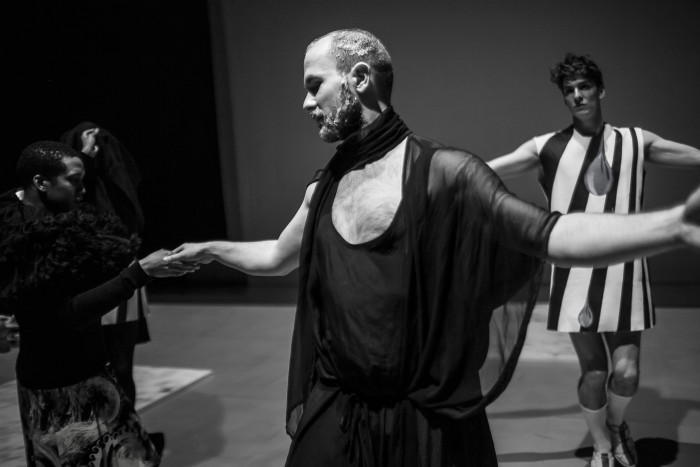
When my work came to visibility I was working with emotions and tears, and it was a taboo at the time. Often I think about this, because I don’t know where the tears come from when I’m performing. As an artist, I don’t try to know everything, I don’t want to know, I want to give space to the spectators and they can complete the work when we perform it together. Interconnectedness activates the performance and also relates back to ritual.
XA: Could we speculate about the connections between contemporary performance and dance with the choreographies of spiritualists and occultist sects that were loosely based on ancient Babylonian, Egyptian, and Greek rituals later adapted by seventeenth century European spiritualists, through the nineteenth century and beyond? Some of these features might appear very clearly in performance, for instance drawing a connection between body, self, and soul, or employing movement as ritualistic repetition or trance. This also means eliminating the status of audience, as everybody is involved in the ritual, there is no spectatorship. It also means creating hybrids that go beyond the modern divisions of human/non-human.
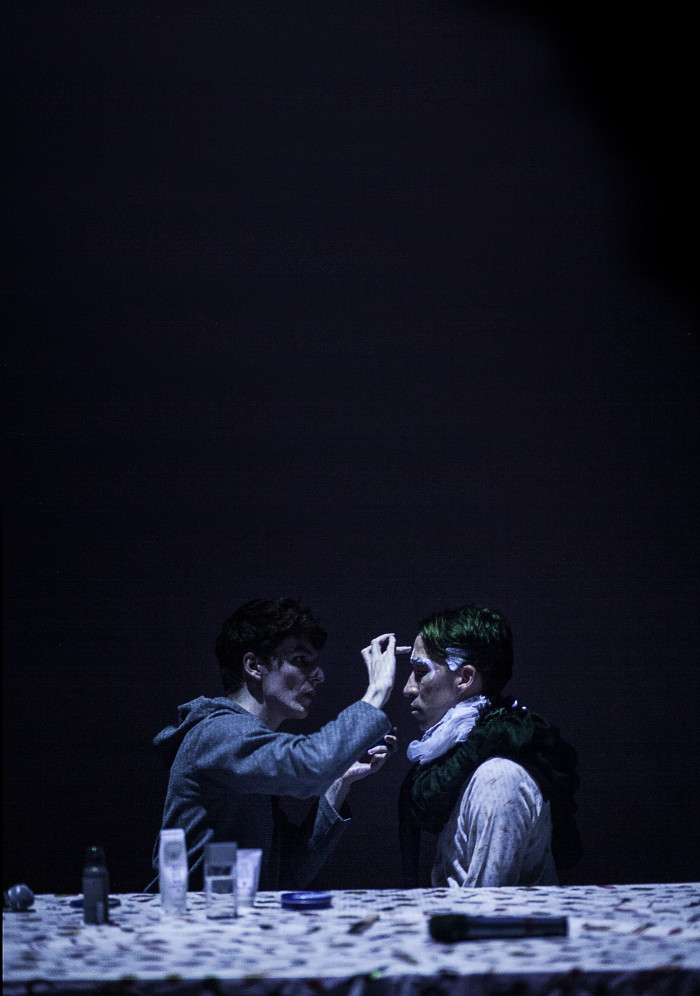
TH: Well, I am not a specialist on these issues. I make very specific propositions to myself and while I am very connected to ancient Greek theater, I don’t try to re-invoke those practices. I am more interested in bringing the aesthetic elements together to make something very contemporary, and then there are the conditions that bring the performance into the now. My interest in Greek theater is based in its influence as the foundation of Western theater, and some of its characteristics are especially interesting: men played male and female roles, which I connect to voguing, and also it was a highly politicized form, in addition to being ritualistic and Dionysian; in its origins it was an invocation of the Gods. That said, I think that the most spiritual is the most concrete, and that is the energy of the now. I’m trying to get people to connect with the person sitting beside them. It is not the extraordinary, it is the very ordinary and recognizable things that we often ignore.
Comments
There are no coments available.